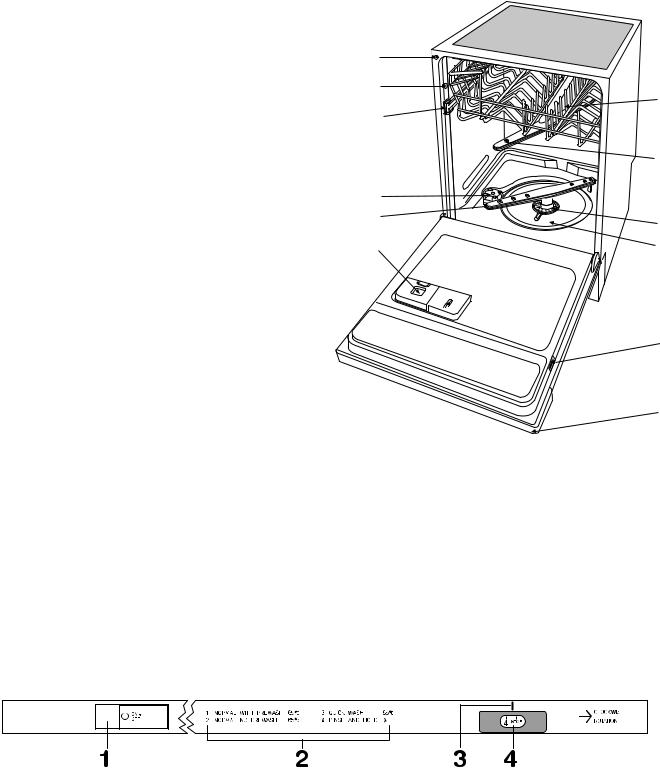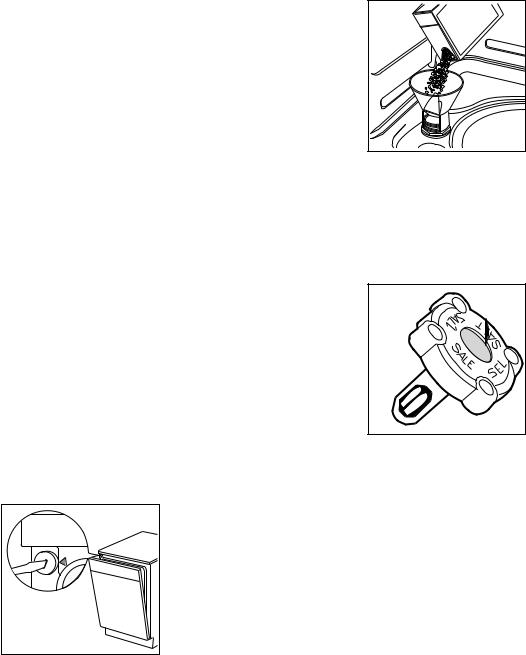Electrolux ESL 624 User Manual

D i s h w a s h e r
Model ESL 624
UK
4 02/02

Contents
Important safety information |
3 |
Hints and tips |
3 |
Description of the appliance |
4 |
The control panel |
4 |
Before use |
5 |
Setting the water softener |
5 |
Filling with salt |
5 |
Rinse aid |
6 |
Use of detergent |
6 |
Using your appliance |
7 |
Loading your appliance |
7 |
The lower basket |
7 |
The cutlery basket |
7 |
The upper basket |
7 |
Adjusting the height of the upper basket |
7 |
Washing programmes |
8 |
Operating sequence |
9 |
Maintenance and cleaning |
10 |
Internal cleaning |
10 |
Cleaning the filters |
10 |
External cleaning |
10 |
Prolonged periods of non-operation |
10 |
Frost precautions |
10 |
Moving the machine |
10 |
Something not working |
11 |
Service and Spare Parts |
12 |
Customer Care Department |
12 |
Guarantee Conditions |
12 |
Installation instructions |
13 |
Water supply connections |
13 |
Water outlet hose connection |
13 |
Electrical connection |
14 |
Hints for test centres |
15 |
Technical specifications
Dimensions |
Width |
59.6 cm |
|
Height |
81.8 - 87.8 cm |
|
Max depth |
55 cm |
|
Max depth with open door |
111.4 cm |
|
|
|
Electrical connection |
Voltage |
220/240 V - 50 Hz |
Motor rating during wash |
|
200 W |
Power of heating element |
|
2100 W |
Overall power |
|
2300 W |
|
|
|
Water supply pressure |
Minimum |
50 kPa (0.5 bar) |
|
Maximum |
800 kPa (8 bar) |
|
|
|
Capacity |
|
12 place settings |
|
|
|
2

Important safety information
It is most important that this instruction book should be retained with the appliance for future reference. Should the appliance be sold or transferred to another owner, or should you move house and leave the appliance, always ensure that the book is left with the appliance in order that the new owner can get to know the functioning of the appliance and the relevant safety information.
This information has been provided in the interest of your safety. You MUST read it carefully before installing or using the appliance.
Installation
●This appliance is heavy. Care should be taken when moving it.
●It is dangerous to alter the specifications or attempt to modify this product in any way.
●Care must be taken to ensure that the appliance does not stand on the electrical supply cable.
●Any electrical work required to install this appliance should be carried out by a qualified electrician or competent person.
●Any plumbing work required to install this appliance should be carried out by a qualified plumber or competent person.
Child Safety
●This appliance is designed to be operated by adults. Children should not be allowed to tamper with the controls or play with the product.
●Keep all packaging well away from children.
●Keep all detergents in a safe place out of children's reach.
During Use
●Items that are contaminated by petrol, paint, steel or iron debris, corrosive, acidic or alkaline chemicals must not be washed in this dishwasher.
●Under no circumstances should you open the door whilst the appliance is in operation. Always turn off the appliance before opening the door.
●Only use detergent specifically designed for use in dishwashers.
●Long bladed knives stored in an upright position are a potential hazard.
●Long and/or sharp items of cutlery such as carving knives must be positioned horizontally in the upper basket.
●When finishing loading or unloading close the door, as an open door can be a hazard.
●Do not sit or stand on the open door.
●Isolate the appliance from the power supply and turn off the water supply after use.
●Care should be taken when cleaning the bottom door seal and hinge area as any exposed metal edges may cut if care is not taken.
●This product should be serviced by an authorised Service engineer, and only genuine spare parts should be used.
●Under no circumstances should you attempt to repair the machine yourself. Repairs carried out by inexperienced persons may cause injury or serious malfunctioning. Contact your local Service Force Centre. Always insist on genuine spare parts.
Conservation
In the interest of the environment:
● Materials marked with the symbol |
are recyclable. |
●Check with your local Council or Environmental Health Office to see if there are facilities in your area for re-cycling this appliance.
●When the appliance is to be scrapped, cut off the power supply cable and make the door closing device unusable to prevent young children from being trapped inside.
●Help to keep your country tidy - use authorised disposal sites for your old appliance.
Hints and tips
To save energy
Place dishes in the machine immediately after every meal and wait until the dishwasher is full before washing.
If necessary run the Rinse and Hold programme (see "Washing Programmes" chart) so that any food scraps do not become caked on the dishes while you are waiting to run the complete wash programme.
Do not prewash dishes under running water.
For best washing and drying results
Before loading, remove all scraps of food and soak very heavily soiled pots and pans.
Arrange saucepans, cups and glasses etc. upside-down. Tilt items with convex or concave surfaces so that the water drains off easily.
Avoid contact between the dishes as far as possible.
Items not suitable for dishwashers
The following items should not be washed in the dishwasher (unless they are sold as dishwasher proof):
- Cutlery with wooden or horn handles or glued parts
-bronze cutlery
-saucepans with wooden handles
-aluminium ware
-crystal ware
-leaded glass
-plastic items
-antique or fine decorated china
Certain types of decoration can discolour when washed in a dishwasher.
Crystal-ware and plastic objects, if not guaranteed dishwasher proof should be washed by hand.
Certain types of glass can also become opaque after being washed several times in a dishwasher.
A chemical reaction can occur between silver cutlery and stainless steel cutlery. As a precaution, do not wash together. Iron and cast iron objects can rust and stain other items. Aluminium tends to go black, copper, pewter and brass tend to stain.
If in doubt check with manufacturer of the item.
When buying new dishes, ensure that they are dishwasher proof.
3

Description of the appliance
1.Water hardness adjustment
2.Levelling spacers
3.Upper basket stop
4. |
Salt container |
1 |
|
|
5. |
Lower spray arm |
2 |
|
|
6. |
Detergent dispenser |
13 |
||
|
||||
7. |
Control panel |
3 |
|
|
|
|
|||
8. |
Rating plate |
|
|
|
9. |
Rinse aid dispenser |
|
12 |
|
|
|
|||
10. |
Large filter |
4 |
|
|
11. |
Central filter |
|
||
5 |
11 |
|||
12. |
Upper spray arm |
|||
|
||||
|
|
|||
13. |
Upper basket |
6 |
10 |
|
|
|
 9
9
8
7
IN85
The control panel
1. |
On/Off push button |
3. |
Programme marker |
2. |
Programme guide |
4. |
Programme selector dial |
4

Before use
Before using your dishwasher for the first time:
1.Ensure that the electrical and water connections comply with the installation instructions
2.Remove all packaging from inside the appliance
3.Set the water softener
4.Pour 1 litre of water inside the salt container and then fill with salt
5.Fill the rinse aid dispenser.
6.Run a "Rinse and Hold" programme.
Filling with salt
Only use salt specifically designed for use in dishwashers.
All other types of salt not specifically designed for use in a dishwasher, especially table salt, will damage the water softener.
Only fill with salt just before starting one of the complete washing programmes. This will prevent any grains of salt
or salty water, which may have been spilled, remaining on the bottom of the machine for any period of time, which may cause corrosion.
Setting the water softener
The dishwasher is equipped with a water softener designed to remove minerals and salts from the water supply, which would have a detrimental or adverse effect on the operation of the appliance.
The higher the content of these salts, the harder your water is.
Water hardness is measured in equivalent scales, Clarke,
French degrees and PPM (parts per Million).
The softener should be adjusted according to the hardness of the water in your area. Your local Water Authority can advise you on the hardness of the water in your area.
The dishwasher is factory set at level 2.
If this level is not suitable for your area the softener should be adjusted.
|
|
|
|
|
|
|
|
|
|
|
|
|
Water hardness |
|
|
|
|
||
|
|
|
|
|
|
|
|
|
|
Clarke |
|
French |
PPM |
Level |
Use of |
||||
degrees |
|
degrees |
(Parts per |
||||||
|
|
|
|
(°TH) |
Million) |
|
salt |
||
|
|
|
|
|
|
|
|||
|
0 - 6 |
|
0 - 8 |
0 - 80 |
0 |
NO |
|||
7 |
- |
14 |
|
9 - 20 |
81 - 200 |
1 |
YES |
||
15 - 28 |
|
21 |
- 40 |
201 |
- 400 |
2 |
YES |
||
29 |
- 42 |
|
41 |
- 60 |
401 |
- 600 |
3 |
YES |
|
43 |
- |
56 |
|
61 |
- 80 |
601 |
- 800 |
4 |
YES |
57 |
- |
63 |
|
81 - 90 |
801 - 900 |
5 |
YES |
||
|
|
|
|
|
|
|
|
|
|
If your water is level 0 it is already soft and therefore there is no need to use salt.
In this case adjust the water softener on level 1 without using salt.
To adjust the water softener
With a screwdriver turn the selector on the upper front corner of the machine until the level required corresponds with the marker.
3 |
4 |
|
5 |
|
1 |
AA05 |
|
To fill: |
|
|
1. |
To fill with salt, unscrew the cap of the salt container. |
|
2. Pour 1 litre of water inside the container (this is |
|
|
|
necessary only before filling with salt for the first time). |
|
3. |
Using the funnel provided, |
|
|
pour in the salt until the |
SALET |
|
container is full. |
|
|
SAL |
|
|
|
|
|
Do not worry if water over |
SALZ |
|
SEL |
|
|
flows from the unit when |
|
|
|
|
|
filling with salt, this is quite |
|
|
normal. |
|
4. |
Replace the cap making |
|
|
sure that there is no trace |
|
|
of salt on the screw thread |
|
|
SR06 |
|
|
or on the gasket. |
|
5. Screw on the cap tightly.
The salt container will require topping up periodically.
The salt cap has a refill indicator window in the centre.
A green float is clearly visible when there is salt inside the container, and almost disappears when the salt has finished reminding you to add salt.
SR11 |
5
